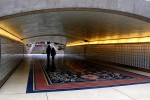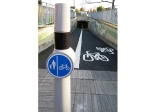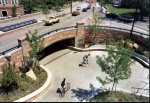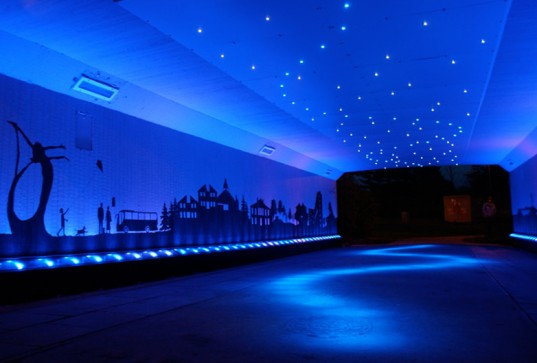“It is difficult to design a space that will not attract people. What is remarkable is how often this has been accomplished” – William H. Whyte.
It is not difficult to design a space that people will love, but it is difficult when the odds are against the designer. I’m talking about pedestrian underpasses – the most ironic design principle dead end.
The intended purpose of a pedestrian underpass aims at introducing a chance for pedestrians to continue their journey and create opportunity for mobility through environments containing blocked areas (highways, buildings, etc), but unfortunately these areas are often left neglected or are poorly designed, plaguing them with negative associations… unsafe, dark, dirty, uncertain, avoid – all percieved descriptors that most people would associate with pedestrian underpasses.
Underpasses strive to connect pedestrians from one side of a pedestrian obstacle to the other, however there are numerous factors that prevent these types of essential connections to fulfill their total potential, such as:
Rundown appearance
Lacking adequate lighting and surveillance
Lacking in pedestrian wayfinding
Decreased on-street vibrancy
Usefulness is not defined
Most underpasses have potential and can be redeveloped into successful pedestrian underpasses by achieving the following:
PUTTING IT ON THE MAP
“You can’t rely on bringing people downtown, you have to put them there.” – Jane Jacobs
 Identity/Landmark: Make the underpass a landmark to help users understand a recognizable point of reference in a larger space to aid with orientation. A character and sense of place will be created. To emphazise the location and its usefulness, the underpass should be highlighted in some way on a network map.
Identity/Landmark: Make the underpass a landmark to help users understand a recognizable point of reference in a larger space to aid with orientation. A character and sense of place will be created. To emphazise the location and its usefulness, the underpass should be highlighted in some way on a network map.
 Navigation: The underpass should clearly navigate users through it as opposed to around it etc. as it is a thoroughfare, not a long-term destination.
Navigation: The underpass should clearly navigate users through it as opposed to around it etc. as it is a thoroughfare, not a long-term destination.
 Signs: By incorporating a sign of the overall pedestrian system near the underpass, the navigator will be able to place the entire space within his or her view and consequently be able to deduce where they are, what is in their immediate vicinity, what destinations are available, how to get there, and how long it will take them (ped shed). The underpass as a decision point will help foster it as a landmark and as a safe and reliable passageway.
Signs: By incorporating a sign of the overall pedestrian system near the underpass, the navigator will be able to place the entire space within his or her view and consequently be able to deduce where they are, what is in their immediate vicinity, what destinations are available, how to get there, and how long it will take them (ped shed). The underpass as a decision point will help foster it as a landmark and as a safe and reliable passageway.
 Sightlines: A first time user may have uncertain expectations as to the underpasses extent and purpose – to avoid this uncertainty, the sightline through the underpass should be clear in order to give the user enough information about what is ahead and to encourage them to move or continue further.
Sightlines: A first time user may have uncertain expectations as to the underpasses extent and purpose – to avoid this uncertainty, the sightline through the underpass should be clear in order to give the user enough information about what is ahead and to encourage them to move or continue further.
![full_melbourne-pedestrian-underpass[1]](https://mycityspot.files.wordpress.com/2013/02/full_melbourne-pedestrian-underpass1.jpg?w=150&h=100) Connectivity: An underpass will only be used if it is connected to a network, therefore it should be connected to some sort of pedestrian system. It is also important for users to be aware of that through marketing, signage, and clarity on-site.
Connectivity: An underpass will only be used if it is connected to a network, therefore it should be connected to some sort of pedestrian system. It is also important for users to be aware of that through marketing, signage, and clarity on-site.
/
MAKING IT SAFE
“What attracts people most, it would appear, is other people.” – William H. Whyte
 Crime Prevention Through Environmental Design (CPTED): CPTED is a great framework for making an underpass approachable and safe, especially because CPTED believes that crime and loss are by-products of human functions that are not working properly. The three overlapping CPTED design strategies are:
Crime Prevention Through Environmental Design (CPTED): CPTED is a great framework for making an underpass approachable and safe, especially because CPTED believes that crime and loss are by-products of human functions that are not working properly. The three overlapping CPTED design strategies are:
 Natural Surveillance: an underpass should be designed in such a way as to facilitate observation by increasing visual permeability and sightlines in order to see what is ahead and around the site. Visual permeability will increase the potential for ‘eyes on the street’. Since sightlines cannot be achieved from all perspectives through an underpass, wayfinding techniques can be used to reassure the user. Encouraging visitors to progressively and passively use the site is also an effective form of natural surveillance.
Natural Surveillance: an underpass should be designed in such a way as to facilitate observation by increasing visual permeability and sightlines in order to see what is ahead and around the site. Visual permeability will increase the potential for ‘eyes on the street’. Since sightlines cannot be achieved from all perspectives through an underpass, wayfinding techniques can be used to reassure the user. Encouraging visitors to progressively and passively use the site is also an effective form of natural surveillance.
 Natural Access Control: an underpass should be designed in such a way as to direct normal access to observable areas and prevent access to unobservable areas. The path should have a clear sense of direction, and wayfinding techniques can create a sense of anticipation for what is coming next to keep movement flowing.
Natural Access Control: an underpass should be designed in such a way as to direct normal access to observable areas and prevent access to unobservable areas. The path should have a clear sense of direction, and wayfinding techniques can create a sense of anticipation for what is coming next to keep movement flowing.
 Territorial Reinforcement: an underpass should be designed in such a way as to enhance the feeling of legitimate ownership by implementing symbolic or psychological barriers such as bollards and signs, and to minimize the creation of ambiguous spaces, such as gaps and corners.
Territorial Reinforcement: an underpass should be designed in such a way as to enhance the feeling of legitimate ownership by implementing symbolic or psychological barriers such as bollards and signs, and to minimize the creation of ambiguous spaces, such as gaps and corners.
Mechanical Forms of Surveillance & Access Control: Such as uniform white lighting should also be applied.
GIVING IT AN IDENTITY
“We will neglect our cities to our peril, for in neglecting them we neglect the nation.” – JFK
 Image: An underpass should be designed in such a way as to enhance and maintain its physical appearance to encourage users of the area to respect their surroundings. The more dilapidated an area, the more vulnerable it is to further abuse.
Image: An underpass should be designed in such a way as to enhance and maintain its physical appearance to encourage users of the area to respect their surroundings. The more dilapidated an area, the more vulnerable it is to further abuse.
 Approach: The entrance and exit of the space should be clearly defined and anticipated using branded signs that tie in with the rest of the trail or the City’s branding, to make it official and trustworthy.
Approach: The entrance and exit of the space should be clearly defined and anticipated using branded signs that tie in with the rest of the trail or the City’s branding, to make it official and trustworthy.
Maintenance: The underpass should be maintained in the following ways – infrastructure maintenance, standard cleaning, and responsive cleaning (graffiti).
Addressing Graffiti: Graffiti can be prevented through design in two ways:
Dimensions & Distractions: for underpasses, a line of street furniture or greenery is not recommended. Instead, 2D or 3D (relief or installation) designs on any of the four facades (walls, ground and cieling) are recommended.
Lighting: often times underpasses are short with an opening in the middle, which is great for lighting. However, with no additional luminaire fixtures the longer underpasses and the night scene for any sized underpass can become quite dreary. Additionally, weak or unpleasant colored lighting (yellow) can be unattractive as well. A well-lit (white) and brightly-colored (white) underpass can put it in a perceived ‘spotlight’ and discourage tagging and even crime due to a fear of being seen and caught. This technique obviously plays a huge role with personal safety as well.
At the end of the day, underpasses may be an awkward problem to solve, but what’s life without a challenge, right? An enjoyable, useful and safe pedestrian underpass is possible.




